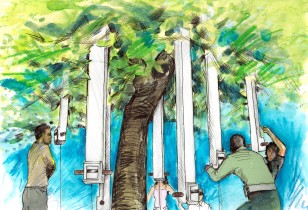Conceptual garden for the 2013 Ellerslie International Flower Show
Christchurch’s magnificent grand old trees have inspired a trio of multi-award winning British designers to design a second conceptual garden for the 2013 Ellerslie International Flower Show.
The Sometimes you need to see what’s above you garden by Britain’s Garden Designer of the Year Andrew Fisher Tomlin, emerging garden designer Tom Harfleet and his artist brother Paul, aims “to get people up close and personal with a tree”.
They say the garden complements their other conceptual garden, Sometimes you need to see what’s behind

you, which asks the viewer to celebrate the beauty of a tree by taking the traditional outward focussed tree seat and turning it inwards.
Fisher Tomlin says their second garden will focus on a single tree. “We will hang nine two-metre long periscopes from the tree, allowing people of all heights to look into the tree and see what is growing above us.
“Conceptual gardens are about ideas and provoking thought; whether people love them or hate them is of almost no consequence. What is important is that there are places where people, not just garden designers, can use the medium of gardens to express and explore ideas.”
Fisher Tomlin, who will also be the Convenor of Judges at this year’s Ellerslie show, has won awards for his work throughout the United Kingdom and internationally, while Tom Harfleet, working with his brother, won Gold and Best Conceptual Garden at Hampton Court in 2010 for his first exhibition, the Pansy Project garden. Tom also won silver gilt in 2011 for his Philips-sponsored Bright Idea garden.
The trio say they intend to donate the periscopes to a local school, leaving a legacy of Ellerslie in Christchurch and they plan to re-create the garden at other shows throughout the world. “There has been a lot of interest in having a similar garden at a show in Sweden and we’re exploring other options within the United Kingdom.
“There is tremendous scope with conceptual gardens to re-create a simple idea in a multitude of settings and achieve a multitude of responses – that is the true beauty of conceptual gardens.”

